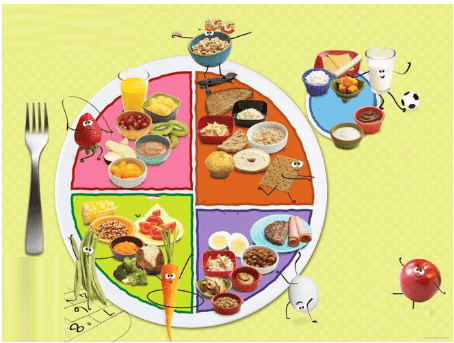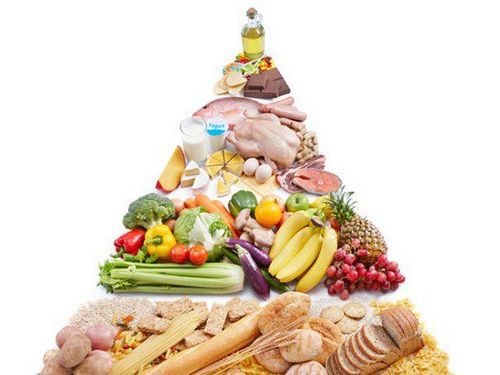This is an automatically translated article.
The balanced nutrition pyramid for preschool children is the basis for choosing foods that ensure adequate nutrition for children's health and development. Based on the nutrition pyramid for preschool children, parents and schools can help children build a scientific and reasonable diet. The Children's Nutrition Pyramid also helps children form healthy and varied eating habits.
1. What is the balanced nutrition pyramid for preschool children?
The balanced nutrition pyramid for preschool children is a pyramidal model that provides information about the recommended food groups and should not be used in the daily meals of preschool and kindergarten children from 3 to 5 years old. Based on the nutrition pyramid, parents as well as caregivers (schools, kindergartens) can build a reasonable diet to ensure adequate nutrition for preschool children so that children can develop. both physically and mentally.
In addition, based on the balanced nutrition pyramid for preschool children, parents and caregivers can easily choose foods that are suitable for children's needs and development, helping children to form a healthy lifestyle. eating habits with a variety of foods. In addition, the nutrition pyramid also notes which foods should be limited in children so that they can balance the amount of food consumed by children, ensuring that the nutrition of preschool children is not unbalanced.
At each age the nutritional pyramid will be different. Therefore, it is necessary to rely on a balanced nutrition pyramid for preschool children to help them build and form a scientific diet and habits.
Reference: Daily balanced nutrition pyramid for 1-2 year olds

Dựa vào tháp dinh dưỡng cân đối cho trẻ mầm non để cung cấp cho trẻ những bữa ăn dinh dưỡng và ngon miệng
2. Nutrition pyramid for preschool children
According to the nutrition pyramid for preschool children, there are 5 main groups of substances that need to be ensured to provide enough for children, including: protein, starch, fat, vitamins and minerals, classified into 7 food groups according to levels The priority is to decrease from bottom to top as follows:
Water: Preschool children need to drink about 6 glasses of water per day, 220ml/glass, equivalent to 1.3 liters of water. In particular, when the weather is hot, children can drink more. However, it should be noted that this amount of water includes milk, fruit juice and filtered water. Cereals: According to the nutrition pyramid for children from 3 to 5 years old, cereals are the second ranked food group, after water. Cereals are the main source of starch for children, helping to convert energy for children to function. Preschoolers need 5-6 units of cereal/day, 1 unit of cereal is equivalent to 1 loaf of bread (27g), half a cup of rice (55g). In the cereal group, priority should be given to rice, noodles, vermicelli, bread, ... because these are starchy foods and provide many other important nutrients. Vegetables and fruits: After cereals, vegetables are the third most important food group according to the nutritional pyramid for preschool children. Every day, children 3 - 5 years old need 4 units of vegetables, 2 units each and each unit corresponds to about 80g. Protein: The protein group includes animal protein (meat, fish, shrimp, crab, egg, ...) and vegetable protein (nuts), in which, consuming vegetable protein is better for health. For children, protein plays an important role, helping children develop both physically and mentally. Every day, preschool children need about 3.5 units of protein, each unit corresponds to about 30-35g of pork, fish, 40-50g of chicken and eggs. Although vegetable protein is better, care should be taken to ensure that children consume both types of protein in a balanced manner. Milk and dairy products: According to the balanced nutrition pyramid for preschool children, every day children in this age group 4 units of milk to ensure their development. 1 unit of milk corresponds to about 100ml of fresh milk or milk powder mixed with water, 15g of cheese, 100g of yogurt. Grease: Preschoolers and preschoolers still need about 5 units of grease per day, each unit corresponds to 5g of fat or cooking oil, 6g of butter. Sugar, salt: Located at the top of the pyramid, salted sugar is the last priority food group, which means that children still need to provide sugar and salt but at a very limited level. According to the balanced nutritional pyramid for preschool children, children need less than 3g of salt and less than 3 units of sugar per day (<15g of sugar), in which salt is the main source of iodine for the body. REFERENCES: 10 good nutrients for 2-4 year olds

Ngũ cốc cho trẻ cung cấp chất bột giúp chuyển hóa năng lượng để trẻ hoạt động
3. Building a menu based on the nutrition pyramid for children
3.1 Principles of building menus based on the nutrition pyramid for preschoolers Based on the nutrition pyramid for preschool children to make menus for children, it is necessary to ensure the following factors:
Provide enough energy for children: It is necessary to provide children with a variety of basic groups of substances such as starch, fiber, protein, fat, vitamins and minerals, to ensure energy for children to function and develop comprehensively. Specifically, the energy requirement of 3 - 5 year old children is about 1,230 - 1,320 kcal/day. Food diversity: In each food group, children should be given a variety of different foods to both change their tastes to help them eat more deliciously, and to ensure a variety of nutrients, and at the same time to help children eat better. Children develop healthy eating habits. However, parents should note that the nutritional pyramid for children is different from that of adults, so there are foods that are good for adults but not suitable for children. Besides, it is also not advisable to change foods between groups. Menus are built according to the seasons and children's preferences: To make children love eating, especially those who are picky eaters leading to malnutrition, parents should develop a menu according to the season and preferences of the child. In particular, with fruits and vegetables, choose seasonal varieties. Choosing safe foods: In addition to ensuring adequate nutrition according to the balanced nutritional pyramid for preschool children, parents also need to pay attention to choosing foods that are safe, not spoiled, rancid, chemicals before processing so as not to affect the health of children. Note for children with allergies: Some children may be allergic to foods such as eggs, milk, nuts, bitter melon, ... Therefore, it is necessary to monitor the child's reaction. when introducing a new food to a child for the first time and avoid it in subsequent uses.

Gợi ý thực đơn dựa vào tháp dinh dưỡng cho trẻ mẫu giáo
3.2 Suggest a menu based on the nutrition pyramid for preschoolers Based on the nutrition pyramid for preschoolers, it is possible to build a menu for each meal for children. Accordingly, to ensure adequate supply of necessary energy and nutrients, 3-5 year olds need 3 main meals and 2 - 3 snacks per day. In which, breakfast and dinner account for 25%/meal, lunch accounts for 40% of energy and dinner accounts for 10%. In each meal, the proportion of groups of substances is distributed as follows: starch accounts for 52-60%, protein accounts for 13-20%, and fat accounts for 25-35%.
The following is a suggested menu according to the nutrition pyramid for preschoolers:
Breakfast: 1 bowl of soup. Breakfast snack: 1 glass of milk 200ml. Lunch:: 1 cup of rice, braised fish, vegetable soup cooked with minced meat, oranges. Afternoon snack: 1 glass of yogurt 100ml. Afternoon-dinner meal: 1 cup of rice, braised chicken, hot vegetable soup cooked with shrimp and banana. Evening snack: 1 glass of milk 200ml. The balanced nutrition pyramid for preschool children is the basis for choosing foods and building menus for children to ensure a healthy, scientific diet, and at the same time provide enough nutrients for children to be healthy and develop. . In addition to nutrition, parents also need to pay attention to the notes when it comes to dental hygiene for preschool children. Because at this age, many children still do not know how to brush their teeth and maintain proper oral hygiene.
In addition to nutrition, children need to be supplemented with zinc daily to eat well, reach the correct height and weight and exceed the standard. Zinc plays a role in affecting most biological processes taking place in the body, especially the breakdown of nucleic acids, proteins... Organs in the body when zinc deficiency can lead to a There are a number of diseases such as neurological disorders, irritability, etc. Therefore, parents need to learn about the role of zinc and guide them to appropriate zinc supplements for their children.
In addition to zinc, parents also need to supplement their children with other important vitamins and minerals such as lysine, chromium, B vitamins,... errands.
Please regularly visit Vinmec.com website and update useful information to take care of your baby and family.













